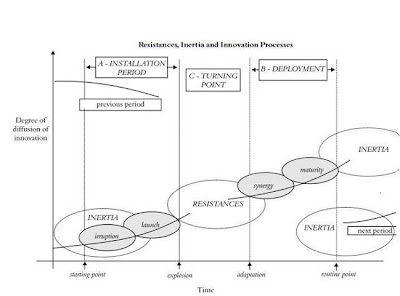GE's 'innovation barometer' shows corporate focus on human need
GE discusses survey results at Davos
Richard Lee, Staff Writer
Published: 10:26 p.m., Friday, January 28, 2011
- John Krenicki, vice chairman of General Electric Co. (GE), speaks during a session on the first day of the World Economic Forum (WEF) Annual Meeting 2011 in Davos, Switzerland, on Wednesday, Jan. 26, 2011. The World Economic Forum in Davos will be attended by a record number of chief executive officers, with a total of 2,500 delegates attending the five-day meeting that starts in the ski resort today. Photographer: Tomohiro Ohsumi/Bloomberg *** Local Caption *** John Krenicki Photo: Bloomberg, Tomohiro Ohsumi / © 2011 Bloomberg Finance LP | Buy This Photo
Timing is crucial in the corporate world, and Fairfield-based General Electric Co., thinks it found the ideal time to release its first "GE Global Innovation Barometer" as its representatives attend the World Economic Forum in Davos, Switzerland.
The barometer, an independent survey of 1,000 business executives in 12 countries, found that the greatest innovations in the future will be those that help address human need, more so than those that simply create the most profit. The report outlines a new landscape for innovation in the 21st century, placing an increased premium on addressing local needs, marshaling the creativity of individuals and smaller organizations and forging strategic partnerships.
The study was commissioned by GE and done by StrategyOne to identify drivers and deterrents of innovation and to analyze perceptions around innovation challenges.
Companies must embrace a new innovation paradigm that promotes collaboration between all levels of corporate players to foster creativity, said Beth Comstock, chief marketing officer and senior vice president of GE, a forum panelist.
The survey revealed that 77 percent of executives who responded believe that the greatest innovations of the 21st century will be those that help address human needs, such as improving health quality, access to education, environmental quality or enhancing energy security -- more than profit, she said.
"This study illustrates that the rules around innovation are changing, and that companies, like ours, will need to evolve our strategy in order to stay competitive, drive growth and contribute meaningfully to the economy," Comstock said in a statement.
Ninety-five percent of executives said innovation is the main lever for a more competitive national economy, and 88 percent agreed that innovation is the best way to create jobs in their country. Eighty-six percent said that 21st-century innovation is about partnerships as opposed to the success of a single organization.
Conducted between Dec. 10 and Jan. 14, the survey asked executives to name the three countries they view as leading innovators. The United States topped the list with 67 percent, followed by Germany (44 percent), Japan (43 percent) and China (35 percent).
Christopher Bruhl, president and chief executive officer of the Business Council of Fairfield County, credited GE for commissioning the survey and sharing the results on an international scale.
"The reported findings are consistent with what we hear from the global, national and local business leaders we work with," he said.
The countries included in the research are Australia, Brazil, China, Germany, India, Israel, Japan, South Korea, Saudi Arabia, UAE, Sweden and the U.S.
The response rate was between 12 and 15 percent, depending on the country, with most respondents having at least 500 employees. The questionnaire was developed by StrategyOne with GE input, said StrategyOne spokesman Antoine Harary, adding the data was processed with no input from GE. The survey firm used a random approach and no GE client list.
Read more: http://www.stamfordadvocate.com/default/article/GE-s-innovation-barometer-shows-corporate-focus-984362.php#ixzz1CUdNwJlE
